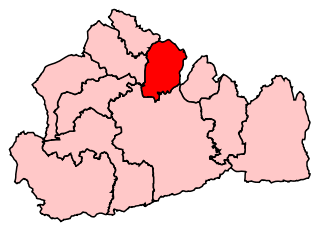
Surrey is a ceremonial county in South East England and one of the home counties. It is bordered by Greater London to the northeast, Kent to the east, East and West Sussex to the south, and Hampshire and Berkshire to the west. The largest settlement is Woking.

Esher and Walton is a constituency in Surrey represented in the House of Commons of the UK Parliament. Since 2010, it has been represented by Dominic Raab of the Conservative Party, who served as deputy prime minister before resigning from that role in April 2023 due to bullying allegations. In May he announced he would be standing down as an MP at the next general election.
Esher was a borough constituency represented in the House of Commons of the Parliament of the United Kingdom. It elected one Member of Parliament (MP) by the first past the post system of election. In the general elections during its 47-year lifetime it was won by three Conservatives successively. In area it shrank in 1974, then regrew in 1983 taking in four sparsely inhabited wards which proved to be temporary, as omitted from the successor seat, Esher and Walton.
Farnham was a constituency covering the south-westernmost and various western parts of Surrey for the House of Commons of the UK Parliament, 1918—1983. Its main successor was South West Surrey. The seat was formed with north-eastern territory including Woking from Chertsey in 1918 and shed the Woking area to form its own seat in 1950. It elected one Member of Parliament (MP). During its 65-year span its voters elected three Conservatives successively.
Chertsey sometimes seen as Surrey North Western, equally the North Western Division of Surrey was created as one of six county constituencies of Surrey for the House of Commons of the UK Parliament. The seat underwent two net reductions and variously included and excluded growing suburban settlements: Egham, Frimley, Weybridge, Walton-on-Thames and Woking.

Mid Surrey was a county constituency in Surrey, England: 1868 — 1885. It returned two Members of Parliament to the House of Commons of the UK Parliament elected by the bloc vote system.

West Surrey was a parliamentary constituency in the county of Surrey, which returned two Members of Parliament (MPs) to the House of Commons of the Parliament of the United Kingdom, elected by the bloc vote system.

Bristol was a European Parliament constituency centred on Bristol in England, but covering much of Avon. Until 1984, it included parts of southern Gloucestershire and northwestern Wiltshire.

Prior to its uniform adoption of proportional representation in 1999, the United Kingdom used first-past-the-post for the European elections in England, Scotland and Wales. The European Parliament constituencies used under that system were smaller than the later regional constituencies and only had one Member of the European Parliament each.

Prior to its uniform adoption of proportional representation in 1999, the United Kingdom used first-past-the-post for the European elections in England, Scotland and Wales. The European Parliament constituencies used under that system were smaller than the later regional constituencies and only had one Member of the European Parliament each.

Prior to its uniform adoption of proportional representation in 1999, the United Kingdom used first-past-the-post for the European elections in England, Scotland and Wales. The European Parliament constituencies used under that system were smaller than the later regional constituencies and only had one Member of the European Parliament each.

Prior to its uniform adoption of proportional representation in 1999, the United Kingdom used first-past-the-post for the European elections in England, Scotland and Wales. The European Parliament constituencies used under that system were smaller than the later regional constituencies and only had one Member of the European Parliament each.

Prior to its uniform adoption of proportional representation in 1999, the United Kingdom used first-past-the-post for the European elections in England, Scotland and Wales. The European Parliament constituencies used under that system were smaller than the later regional constituencies and only had one Member of the European Parliament each.

Prior to its uniform adoption of proportional representation in 1999, the United Kingdom used first-past-the-post for the European elections in England, Scotland and Wales. The European Parliament constituencies used under that system were smaller than the later regional constituencies and only had one Member of the European Parliament each.

Prior to its uniform adoption of proportional representation in 1999, the United Kingdom used first-past-the-post for the European elections in England, Scotland and Wales. The European Parliament constituencies used under that system were smaller than the later regional constituencies and only had one Member of the European Parliament each.




